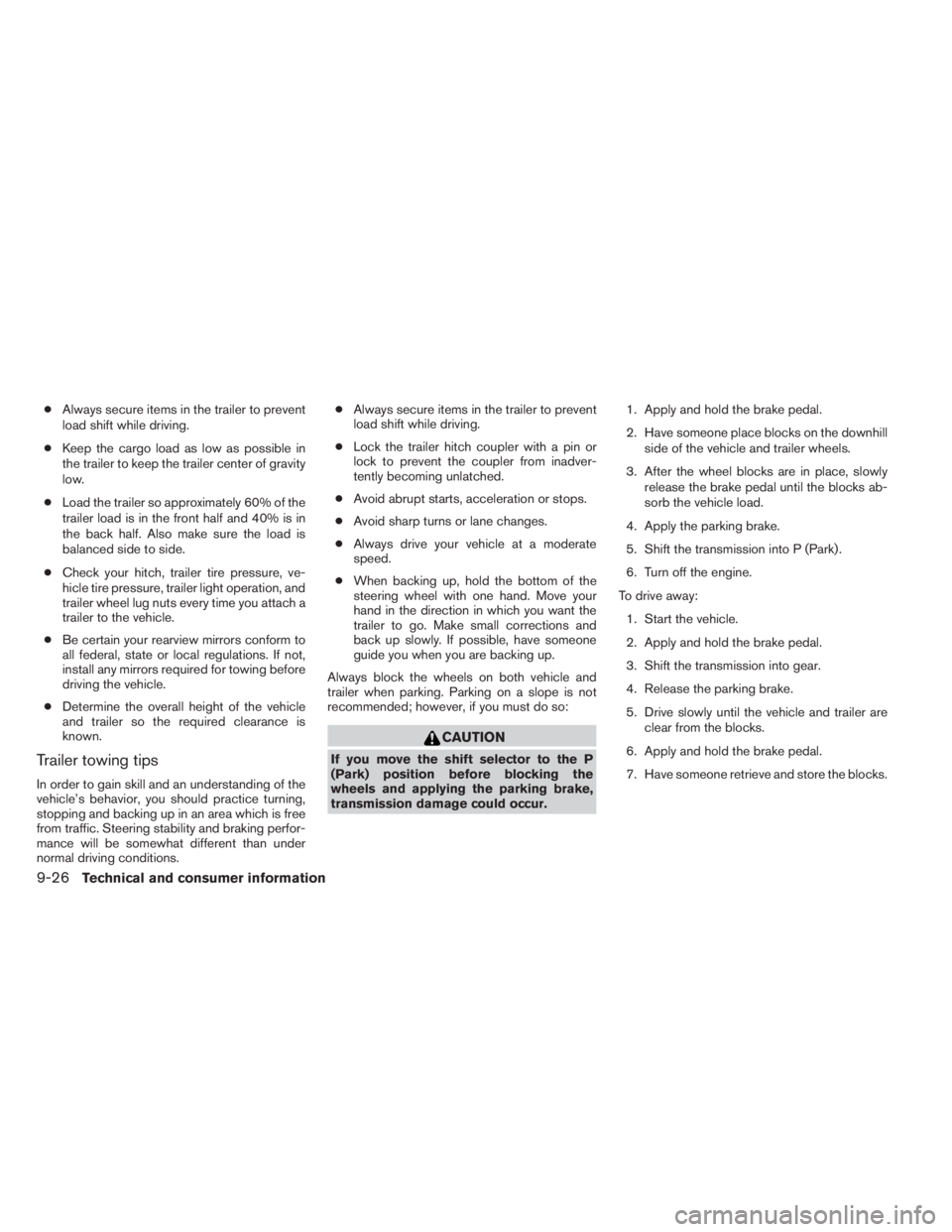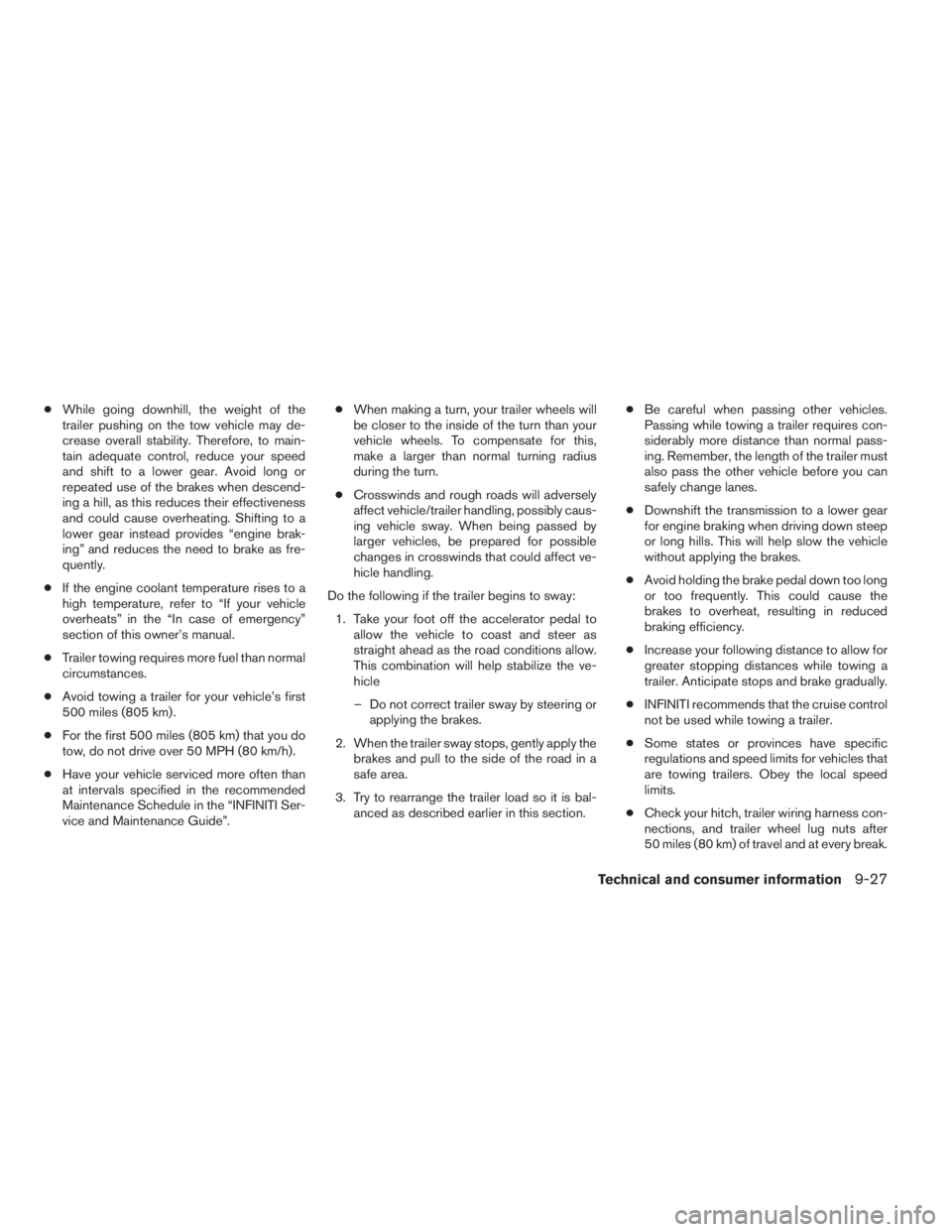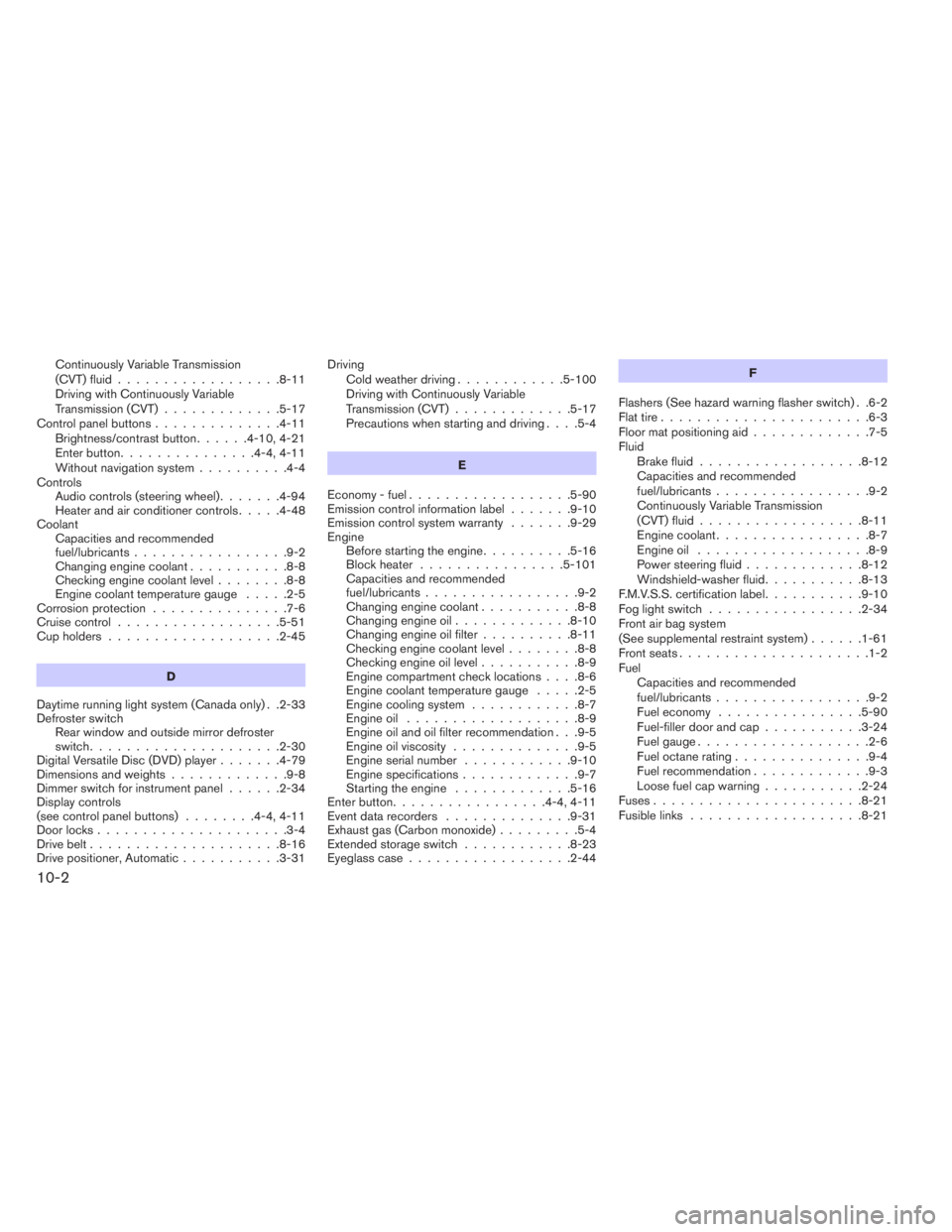Transmission and engine INFINITI QX60 HYBRID 2014 Owner's Guide
[x] Cancel search | Manufacturer: INFINITI, Model Year: 2014, Model line: QX60 HYBRID, Model: INFINITI QX60 HYBRID 2014Pages: 625, PDF Size: 8.01 MB
Page 586 of 625

The following are approximate capacities. The actual refill capacities may be slightly different. When refilling, follow the procedure
described in the “Maintenance and do-it-yourself” section to determine the proper refill capacity.
Capacity (Approximate) Recommended Fluids and Lubricants
US measure Imp measure Liter
Fuel 19-1/2 gal 16-1/4 gal 74.0 See “Fuel recommendation” later in this section.
Engine oil *7
Drain and Refill
With oil filter
change5-1/8 qt 4-1/4 qt 4.8 Genuine NISSAN engine oil or equivelant *2
• Engine oil with API Certification Mark
• Viscosity SAE 5W-30
Without oil filter
change4-3/4 qt 4 qt 4.5
Cooling system
With reservoir 2-1/2 gal 2-1/8 gal 9.6 Pre-diluted Genuine NISSAN Long Life Antifreeze/Coolant (blue) or equivalent
Continuously Variable Transmission (CVT) fluid — — — Genuine NISSAN CVT Fluid NS-3 *3
Power steering fluid (PSF) — — — Genuine NISSAN E-PSF or equivalent.*4
Differential gear oil — — — Genuine NISSAN Differential Oil Hypoid Super Semi-Synthetic API GL-5, Vis-
cosity SAE 75W-90 *8
Transfer fluid — — — API GL-5, Viscosity SAE 80W-90 or equivalent
Brake fluid — — — Genuine NISSAN Super Heavy Duty Brake Fluid *5 or equivalent DOT 3
Multi-purpose grease — — — NLGI No. 2 (Lithium Soap base)
Air conditioning system refrigerant — — — HFC-134a (R-134a) *6
Air conditioning system oil — — — Genuine NISSAN A/C System Oil Type S or equivalent *6
Windshield-washer fluid 1-1/4 gal 1 gal 4.6 Genuine NISSAN Windshield Washer Concentrate Cleaner & Antifreeze fluid or
equivalent
*1: For further details, see “Engine oil and oil filter recommendations” in this section.
*2: INFINITI recommends Genuine NISSAN Ester Oil available at an INFINITI dealer.
*3:Use only Genuine NISSAN CVT Fluid NS-3. Using transmission fluid other than Genuine NISSAN CVT Fluid NS-3 will damage the CVT, which is not covered by
the INFINITI new vehicle limited warranty.
*4: Use of power steering fluid other than Genuine NISSAN E-PSF will prevent the power steering system from operating properly.
*5: Available in mainland USA through an INFINITI retailer.
*6: For further details, see “Air conditioner system refrigerant and oil recommendations” in this section.
*7: For further details, see “Engine Oil” in the “Maintenance and do-it-yourself” section of this manual.
*8: The use of differential gear oil other than the specified may cause vehicle malfunctions and result in non-warranty vehicle repairs.
CAPACITIES AND RECOMMENDED
FUEL/LUBRICANTS
9-2Technical and consumer information
Page 610 of 625

●Always secure items in the trailer to prevent
load shift while driving.
●Keep the cargo load as low as possible in
the trailer to keep the trailer center of gravity
low.
●Load the trailer so approximately 60% of the
trailer load is in the front half and 40% is in
the back half. Also make sure the load is
balanced side to side.
●Check your hitch, trailer tire pressure, ve-
hicle tire pressure, trailer light operation, and
trailer wheel lug nuts every time you attach a
trailer to the vehicle.
●Be certain your rearview mirrors conform to
all federal, state or local regulations. If not,
install any mirrors required for towing before
driving the vehicle.
●Determine the overall height of the vehicle
and trailer so the required clearance is
known.
Trailer towing tips
In order to gain skill and an understanding of the
vehicle’s behavior, you should practice turning,
stopping and backing up in an area which is free
from traffic. Steering stability and braking perfor-
mance will be somewhat different than under
normal driving conditions.●Always secure items in the trailer to prevent
load shift while driving.
●Lock the trailer hitch coupler with a pin or
lock to prevent the coupler from inadver-
tently becoming unlatched.
●Avoid abrupt starts, acceleration or stops.
●Avoid sharp turns or lane changes.
●Always drive your vehicle at a moderate
speed.
●When backing up, hold the bottom of the
steering wheel with one hand. Move your
hand in the direction in which you want the
trailer to go. Make small corrections and
back up slowly. If possible, have someone
guide you when you are backing up.
Always block the wheels on both vehicle and
trailer when parking. Parking on a slope is not
recommended; however, if you must do so:
CAUTION
If you move the shift selector to the P
(Park) position before blocking the
wheels and applying the parking brake,
transmission damage could occur.1. Apply and hold the brake pedal.
2. Have someone place blocks on the downhill
side of the vehicle and trailer wheels.
3. After the wheel blocks are in place, slowly
release the brake pedal until the blocks ab-
sorb the vehicle load.
4. Apply the parking brake.
5. Shift the transmission into P (Park) .
6. Turn off the engine.
To drive away:
1. Start the vehicle.
2. Apply and hold the brake pedal.
3. Shift the transmission into gear.
4. Release the parking brake.
5. Drive slowly until the vehicle and trailer are
clear from the blocks.
6. Apply and hold the brake pedal.
7. Have someone retrieve and store the blocks.
9-26Technical and consumer information
Page 611 of 625

●While going downhill, the weight of the
trailer pushing on the tow vehicle may de-
crease overall stability. Therefore, to main-
tain adequate control, reduce your speed
and shift to a lower gear. Avoid long or
repeated use of the brakes when descend-
ing a hill, as this reduces their effectiveness
and could cause overheating. Shifting to a
lower gear instead provides “engine brak-
ing” and reduces the need to brake as fre-
quently.
●If the engine coolant temperature rises to a
high temperature, refer to “If your vehicle
overheats” in the “In case of emergency”
section of this owner’s manual.
●Trailer towing requires more fuel than normal
circumstances.
●Avoid towing a trailer for your vehicle’s first
500 miles (805 km) .
●For the first 500 miles (805 km) that you do
tow, do not drive over 50 MPH (80 km/h).
●Have your vehicle serviced more often than
at intervals specified in the recommended
Maintenance Schedule in the “INFINITI Ser-
vice and Maintenance Guide”.●When making a turn, your trailer wheels will
be closer to the inside of the turn than your
vehicle wheels. To compensate for this,
make a larger than normal turning radius
during the turn.
●Crosswinds and rough roads will adversely
affect vehicle/trailer handling, possibly caus-
ing vehicle sway. When being passed by
larger vehicles, be prepared for possible
changes in crosswinds that could affect ve-
hicle handling.
Do the following if the trailer begins to sway:
1. Take your foot off the accelerator pedal to
allow the vehicle to coast and steer as
straight ahead as the road conditions allow.
This combination will help stabilize the ve-
hicle
– Do not correct trailer sway by steering or
applying the brakes.
2. When the trailer sway stops, gently apply the
brakes and pull to the side of the road in a
safe area.
3. Try to rearrange the trailer load so it is bal-
anced as described earlier in this section.●Be careful when passing other vehicles.
Passing while towing a trailer requires con-
siderably more distance than normal pass-
ing. Remember, the length of the trailer must
also pass the other vehicle before you can
safely change lanes.
●Downshift the transmission to a lower gear
for engine braking when driving down steep
or long hills. This will help slow the vehicle
without applying the brakes.
●Avoid holding the brake pedal down too long
or too frequently. This could cause the
brakes to overheat, resulting in reduced
braking efficiency.
●Increase your following distance to allow for
greater stopping distances while towing a
trailer. Anticipate stops and brake gradually.
●INFINITI recommends that the cruise control
not be used while towing a trailer.
●Some states or provinces have specific
regulations and speed limits for vehicles that
are towing trailers. Obey the local speed
limits.
●Check your hitch, trailer wiring harness con-
nections, and trailer wheel lug nuts after
50 miles (80 km) of travel and at every break.
Technical and consumer information9-27
Page 615 of 625

WARNING
A vehicle equipped with All -Wheel Drive
(AWD) should never be tested using a two
wheel dynamometer (such as the dyna-
mometers used by some states for emis-
sions testing) , or similar equipment. Make
sure you inform the test facility personnel
that your vehicle is equipped with AWD
before it is placed on a dynamometer.
Using the wrong test equipment may re-
sult in transmission damage or unex-
pected vehicle movement which could re-
sult in serious vehicle damage or personal
injury.
Due to legal requirements in some states and
Canadian Provinces, your vehicle may be re-
quired to be in what is called the “ready condi-
tion” for an Inspection/Maintenance (I/M) test of
the emission control system.
The vehicle is set to the “ready condition” when it
is driven through certain driving patterns. Usually,
the ready condition can be obtained by ordinary
usage of the vehicle.
If a powertrain system component is repaired or the
battery is disconnected, the vehicle may be reset to
a “not ready” condition. Before taking the I/M test,
check the vehicle’s inspection/maintenance test
readiness condition. Place the ignition switch in the
ON position without starting the engine. If the
Malfunction Indicator Light (MIL) comes on steady
for 20 seconds and then blinks for 10 seconds , the
I/M test condition is “not ready”. If the MIL does not
blink after 20 seconds, the I/M test condition is
“ready”. Contact a INFINITI retailer to set the “ready
condition” or to prepare the vehicle for testing.This vehicle is equipped with an Event Data Re-
corder (EDR) . The main purpose of an EDR is to
record, in certain crash or near crash-like situa-
tions, such as an air bag deployment or hitting a
road obstacle, data that will assist in understand-
ing how a vehicle’s systems performed. The EDR
is designed to record data related to vehicle
dynamics and safety systems for a short period of
time, typically 30 seconds or less. The EDR in this
vehicle is designed to record such data as:
●How various systems in your vehicle were
operating;
●Whether or not the driver and passenger
safety belts were buckled/fastened;
●How far (if at all) the driver was depressing
the accelerator and/or brake pedal; and,
●How fast the vehicle was traveling.
●Sounds are not recorded.
These data can help provide a better understand-
ing of the circumstances in which crashes and
injuries occur. NOTE: EDR data are recorded by
your vehicle only if a nontrivial crash situation
occurs; no data are recorded by the EDR under
normal driving conditions and no personal data
(e.g. name, gender, age and crash location) are
recorded. However, other parties, such as law
enforcement, could combine the EDR data with
READINESS FOR INSPECTION/
MAINTENANCE (I/M) TESTEVENT DATA RECORDERS (EDR)
Technical and consumer information9-31
Page 617 of 625

10 Index
A
Aiming control, headlights...........2-33
Air bag (See supplemental restraint
system) .....................1-53
Air bag system
Front (See supplemental front impact
air bag system)...............1-61
Airbagwarninglabels.............1-68
Airbagwarninglight...........1-69,2-11
Air cleaner housing filter............8-18
Air conditioner
Air conditioner service...........4-53
Air conditioner specification label.....9-11
Air conditioner system refrigerant and
oil recommendations.............9-6
Heater and air conditioner controls....4-48
Servicing air conditioner..........4-53
Alarm system
(See vehicle security system).........2-24
Anchor point locations.............1-37
Antenna.....................4-96
Anti-lock brake warning light..........2-7
Anti-lock Braking System (ABS)........5-95
Audible reminders...............2-13
Audio system..................4-54
Bluetooth®audio..............4-91
Compact disc (CD) player.........4-75
FM/AM/SAT radio with compact disc
(CD)player.................4-70
Audio System
iPod®Player................4-87Audio system
Radio ....................4-54
Steering wheel audio control switch . . .4-94
USB interface................4-82
Autolight switch.................2-31
Automatic
Automatic drive positioner.........3-31
Automatic power window switch.....2-51
Automatic anti-glare inside mirror.......3-29
Automatic door locks..............3-6
B
Battery......................8-14
Charge warning light.............2-8
Before starting the engine...........5-16
Belt (See drive belt)..............8-16
Block heater
Engine...................5-101
Bluetooth®audio................4-91
Bluetooth® hands-free phone
system.................4-109, 4-123
Boosterseats..................1-49
Brake
Anti-lock Braking System (ABS)......5-95
Brake fluid..................8-12
Brake light (See stop light).........8-26
Brake system................5-94
Brake warning light..............2-8
Brake wear indicators........2-13,8-20
Parking brake operation..........5-21
Self-adjusting brakes............8-20Brakes......................8-20
Break-inschedule ...............5-89
Brightness/contrast button.......4-10,4-21
Brightness control
Instrument panel..............2-34
Bulb check/instrument panel..........2-7
Bulbreplacement................8-26
C
Capacities and recommended
fuel/lubricants...................9-2
Cargolight ...................2-56
Cargo (See vehicle loading information) . . .9-13
Car phone or CB radio............4-109
CD care and cleaning.............4-94
CD player (See audio system).........4-75
Check tire pressure...............2-23
Child restraints.......1-31,1-31,1-32,1-34
Precautions on child
restraints........1-32,1-40,1-44,1-49
Top tether strap anchor point locations . .1-37
Child restraint with top tether strap......1-37
Child safety rear door lock............3-7
Chimes,audiblereminders...........2-13
Cleaning exterior and interior..........7-2
C.M.V.S.S. certification label..........9-10
Cold weather driving.............5-100
Compact disc (CD) player...........4-75
Consolebox...................2-47
Continuously Variable Transmission (CVT) . .5-17
Page 618 of 625

Continuously Variable Transmission
(CVT) fluid..................8-11
Driving with Continuously Variable
Transmission (CVT).............5-17
Control panel buttons..............4-11
Brightness/contrast button......4-10,4-21
Enterbutton...............4-4,4-11
Without navigation system..........4-4
Controls
Audiocontrols(steeringwheel).......4-94
Heater and air conditioner controls.....4-48
Coolant
Capacities and recommended
fuel/lubricants.................9-2
Changing engine coolant...........8-8
Checking engine coolant level........8-8
Engine coolant temperature gauge.....2-5
Corrosionprotection ...............7-6
Cruisecontrol..................5-51
Cupholders...................2-45
D
Daytime running light system (Canada only) . .2-33
Defroster switch
Rear window and outside mirror defroster
switch.....................2-30
Digital Versatile Disc (DVD) player.......4-79
Dimensionsandweights.............9-8
Dimmer switch for instrument panel......2-34
Display controls
(seecontrolpanelbuttons) ........4-4,4-11
Door locks.....................3-4
Drive belt.....................8-16
Drive positioner, Automatic...........3-31Driving
Cold weather driving............5-100
Driving with Continuously Variable
Transmission (CVT).............5-17
Precautions when starting and driving....5-4
E
Economy - fuel..................5-90
Emission control information label.......9-10
Emission control system warranty.......9-29
Engine
Before starting the engine..........5-16
Block heater................5-101
Capacities and recommended
fuel/lubricants.................9-2
Changingenginecoolant...........8-8
Changingengineoil.............8-10
Changing engine oil filter..........8-11
Checking engine coolant level........8-8
Checking engine oil level...........8-9
Engine compartment check locations....8-6
Engine coolant temperature gauge.....2-5
Engine cooling system............8-7
Engineoil ...................8-9
Engine oil and oil filter recommendation . . .9-5
Engine oil viscosity..............9-5
Engine serial number............9-10
Engine specifications.............9-7
Starting the engine.............5-16
Enterbutton.................4-4,4-11
Eventdatarecorders ..............9-31
Exhaust gas (Carbon monoxide).........5-4
Extended storage switch............8-23
Eyeglass case..................2-44F
Flashers (See hazard warning flasher switch) . .6-2
Flat tire.......................6-3
Floor mat positioning aid.............7-5
Fluid
Brake fluid..................8-12
Capacities and recommended
fuel/lubricants.................9-2
Continuously Variable Transmission
(CVT) fluid..................8-11
Engine coolant.................8-7
Engine oil
...................8-9
Power steering fluid.............8-12
Windshield-washer fluid...........8-13
F.M.V.S.S. certification label...........9-10
Foglightswitch .................2-34
Front air bag system
(See supplemental restraint system)......1-61
Front seats.....................1-2
Fuel
Capacities and recommended
fuel/lubricants.................9-2
Fuel economy................5-90
Fuel-filler door and cap...........3-24
Fuelgauge...................2-6
Fuel octane rating...............9-4
Fuel recommendation.............9-3
Loose fuel cap warning...........2-24
Fuses.......................8-21
Fusiblelinks ...................8-21
10-2
Page 622 of 625

Rear window wiper and washer
switches...................2-29
Turnsignalswitch..............2-34
Vehicle dynamic control (VDC) off
switch.....................2-40
Windshield wiper and washer switch . . .2-26
T
Tachometer....................2-5
Temperature gauge
Engine coolant temperature gauge.....2-5
Theft
(INFINITI vehicle immobilizer system) ,
engine start...........2-25,3-4,5-15
Three-way catalyst................5-4
Tire
Flat tire.....................6-3
Spare tire...................6-5
Tire and Loading Information label.....9-11
Tire chains..................8-37
Tireplacard..................9-11
Tirepressure.................8-30
Tire rotation..................8-37
Types of tires.................8-36
Uniform tire quality grading.........9-28
Wheels and tires...............8-30
Wheel/tire size.................9-8
Tire pressure
Low tire pressure warning light........2-8
Tire Pressure Monitoring System (TPMS)....5-5
Top tether strap child restraint.........1-37
Towing
Flattowing..................9-28
Towingload/specification..........9-21Towtrucktowing...............6-13
Trailer towing.................9-17
Transceiver
HomeLink® Universal Transceiver.....2-57
Transmission
Continuously Variable Transmission
(CVT) fluid..................8-11
Driving with Continuously Variable
Transmission (CVT).............5-17
Travel (See registering your vehicle in another
country)......................9-9
Trip odometer...................2-4
Turn signal switch................2-34
U
Uniform tire quality grading...........9-28
USB interface
Audio file operation.............4-83
Video file operation.............4-85
V
Vanity mirror...................3-29
Variable voltage control system.........8-16
Vehicle dimensions and weights.........9-8
Vehicle dynamic control (VDC) off switch . . .2-40
Vehicle dynamic control (VDC) system.....5-96
Vehicle identification...............9-9
Vehicle identification number (VIN)
(Chassis number).................9-9
Vehicle identification number (VIN) plate....9-9
Vehicle loading information...........9-13
Vehicle recovery..............6-15,6-16Vehicle security system.............2-24
(INFINITI vehicle immobilizer system) ,
enginestart ...........2-25,3-4,5-15
Ventilators....................4-46
Visors.......................3-28
Voice recognition system...........4-134
W
Warning
Airbagwarninglight.........1-69, 2-11
Anti-lock brake warning light.........2-7
Battery charge warning light
.........2-8
Brake warning light..............2-8
Hazard warning flasher switch........6-2
Low fuel warning light........2-10, 2-22
Low tire pressure warning light........2-8
Low windshield-washer fluid warning
light......................2-23
Passenger air bag and status light.....1-62
Seatbeltwarninglight............2-11
Vehicle security system...........2-24
Warning/indicator lights and audible
reminders ...................2-7
Warning labels (for SRS)..........1-68
Warninglights...................2-7
Washer switch
Rear window wiper and washer
switches...................2-29
Windshield wiper and washer switch . . .2-26
Weights (See dimensions and weights).....9-8
Wheels and tires.................8-30
Wheel/tire size...................9-8
When traveling or registering your vehicle
in another country.................9-9
10-6